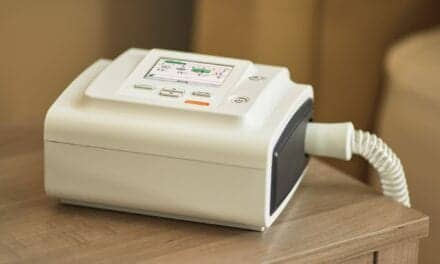 |
Approximately 26.1% of the American population is obese.1 An obese person weighs 20% or more than their ideal weight; an individual who weighs at least 100 pounds more than the ideal weight is severely obese, and a person who weighs at least 200 pounds more than the ideal weight is morbidly obese. At least 70%2,3 of morbidly obese people have symptoms of obstructive sleep apnea, and for many of them, weight loss can reduce the severity of OSA symptoms.
Many obese people are incapable of reducing to and maintaining their ideal weight, however, and the advent of bariatric surgery has made permanent weight loss feasible for many of these individuals. Symptoms of OSA often decrease after the surgery, and, because the postsurgical reduction in OSA symptoms can be significant, some scientists have wondered whether bariatric surgery could be used as an OSA treatment in morbidly obese people. Scientists do not know the extent that bariatric surgery can improve OSA symptoms, however, since most studies2 investigating this issue have been case studies involving one or two people or have involved a very small number of patients who were followed for a short time post surgery. Recently, a team of scientists from the University of Toronto followed the course of OSA in a group of morbidly obese patients 1½ years after bariatric surgery. Their results support the findings of the smaller studies.
Obesity Has Consequences
Obesity impacts all aspects of a person’s life. Some of these consequences are an inability to take part in normal activities; overt and covert social rejection; difficulty with mobility; inability to work; and struggles with depression, low self-esteem, or other psychological problems.
The greatest impact of obesity is medical. Obese people have an increased risk of developing diabetes, cardiovascular problems, high levels of lipids, and OSA. Americans spend approximately $100 billion annually on medical costs attributable to diseases associated with overweight and obesity (whether paid directly, by insurance, or by social health programs such as Medicare or Medicaid).4,5
One’s risk of mortality from obesity-related illnesses increases with increasing weight. Epidemiological studies5 indicate that the risk of mortality begins to increase when a person is obese, but the risk of mortality from all causes (especially cardiovascular diseases) increases more dramatically—by 50% to 100%—in people who are severely obese, compared with a person who is at an ideal weight.
In 2005, the American College of Physicians recommended bariatric surgery as a weight loss treatment option for morbidly obese people.6 Surgery with a specific focus on controlling weight in morbidly obese people was first developed in the 1960s. In 1969, Mason and Ito7 described a surgery in which the upper and lower stomach segments are separated but not removed. The researchers connected the upper portion of the stomach directly to the jejunum, which begins the second portion of the small intestine. The lower stomach still remained attached to the duodenum, which is the first part of the small intestine. As a result, the lower stomach can still receive central nervous system signals to produce gastric fluids in response to eating, although no food passes through it. The fluids flow from the upper intestine through the small intestine and are available to help in digestion once the food reaches the lower region of the small intestine. Meanwhile, the upper segment of the stomach is reduced to about the size of a walnut and quickly fills, allowing the person to more quickly feel full and stop eating.
Mason and Ito assessed the weight loss effects of this surgery in 34 patients. All of the patients initially lost weight, and 94% of the patients successfully maintained their surgery-induced weight loss on follow-up assessments 1 to 3 years later. Although some had regained some of the weight, it did not return to the presurgical level.
Although weight loss helps improve symptoms of OSA, and bariatric surgery helps a person maintain permanent weight loss, scientists at this time can not recommend bariatric surgery as a treatment for OSA. Studies give conflicting results concerning the extent that bariatric surgery is effective in treating OSA.
Does Weight Loss Decrease OSA Symptoms?
Researcher Christopher Lettieri in two separate studies found that surgery-induced weight loss does not resolve or significantly decrease OSA symptoms. The first study8 involved 24 patients. He found that 71% of the patients continued to have moderate to severe OSA after the surgery. In the second study,9 which involved 342 patients, he found that the subjects’ postsurgical apnea-hypopnea index (AHI) remained in the moderately severe range. Lettieri concluded from these results that a person may still need OSA treatment after bariatric surgery.
On the other hand, University of Toronto scientists Leandro Fritscher2 and colleagues in their 2007 study noted that the improvement in OSA symptoms increased with increasing weight loss in subjects who had had bariatric surgery. Before the surgery, the subjects had moderate to severe OSA, as reflected by an AHI, on average, of 47 events/hour. The patients lost an average of nearly 71% of their body weight when followed up 1½ years later. After surgery, the AHI in 50% of the subjects fell to an average of 16 events/hour; 25% of the patients no longer had sleep apnea. The remaining 25% who did not improve had had the heaviest presurgical weight. Even when the AHI did not decrease, the person had improved nocturnal oxygen blood saturation. Although the Fritscher study focus was on the impact of weight loss surgery on symptoms of OSA, rather than whether the surgery could be a treatment for OSA in morbidly obese people, he concluded that weight loss surgery results in significant, long-term improvements in respiration and oxygenation in formerly morbidly obese people.
The goals of an effective weight loss and management program5 are to reduce body weight (by at least 10%) and to either maintain the lower body weight long term or prevent further weight gain. Ideally, a person should lose the first 10% (or 1 to 1½ pounds per week) within 6 months. At approximately 6 months, a person often reaches a plateau at which it becomes more difficult to continue losing weight. At that point, the person may need to alter their weight reduction plan, perhaps finding other means to decrease calorie intake or increasing exercise, in order to continue losing weight. Once the goal weight is reached, weight maintenance becomes the focus. Successful weight maintenance is a weight regain of less than 6.6 pounds (3 kg) in 2 years and a sustained reduction in waist circumference of at least 1.6 inches (4 cm).
People who have undergone bariatric surgery can lose more than 10% of their body weight within 6 months compared with a person who is losing weight through nonsurgical means (eg, dieting, exercise, drug therapy). Because of the more rapid weight loss after bariatric surgery, the most effective treatment for their OSA—positive airway pressure (PAP)—can quickly become ineffective. If a prescribed pressure is too low, apneas can still occur. If a prescribed pressure is too high, a person will feel uncomfortable and may discontinue the therapy.
Weight reduction often reduces a person’s pressure needs, but rapid weight reduction potentially means that a person’s pressure needs rapidly change. This creates a problem for an individual prescribed CPAP or BPAP, since that person would frequently need to come to a sleep center to have the pressure of their CPAP/BPAP machine appropriately adjusted. Therefore, CPAP and BPAP may not be effective for a person who is quickly losing weight after bariatric surgery. Recently, Kuzniar and Morgenthaler10 suggested using autotitrating PAP (APAP) to address this problem.
Kuzniar and Morgenthaler reported their experience using APAP treatment in a 27-year-old man who underwent bariatric surgery. Before the surgery, the patient had an AHI of 44 events/hour. His CPAP titration study indicated that a pressure of 15 cm H2O resolved his apnea when he was supine and in REM sleep, but his pressure requirements fell to 10 to 12 cm H2O when in non-REM (NREM) sleep. Because of this drastic difference in pressure requirement, the researchers prescribed the patient APAP therapy, setting the minimum at 10 cm H2O and the maximum at 20 cm H2O. Data from the APAP machine at 6 weeks post surgery showed that the effective pressure to resolve apnea during that time had fallen from 18 cm H2O to 10 cm H2O and the patient’s median PAP needs fell from 16 cm H2O to 8 cm H2O. In response to this decline in pressure need, the researchers reset the APAP’s minimum pressure to 5 cm H2O. (Seven months after the surgery, the patient had lost about 34% of his initial weight.) Kuzniar and Morgenthaler propose that APAP may be an option for apnea treatment while a person is rapidly losing weight after bariatric surgery and if the person does not have other respiratory diseases such as chronic obstructive pulmonary disease (COPD), congestive heart failure, or obesity-hypoventilation syndrome.
|
Editor’s Note |
Several surgeries exist for treating OSA. These surgeries restructure the upper airway so that it remains open during sleep. Some scientists have conjectured that bariatric surgery, by inducing weight loss, could be a treatment for sleep apnea in severely and morbidly obese people. Currently, most studies indicate that bariatric surgery may not be as feasible for OSA treatment in severely and morbidly obese people as it is for weight reduction. Nevertheless, studies show there is a significant reduction in OSA symptoms after bariatric surgery. Many studies have focused on the efficacy and safety of bariatric surgery in people with OSA. Scientists are just beginning to broaden their interests concerning the full impact of the bariatric surgery on OSA symptoms. For now, residual apneas in people who have undergone bariatric surgery are typically treated with PAP therapy. Future studies may determine how to resolve residual apnea in greater numbers of formerly severely or morbidly obese people.
Regina Patrick, RPSGT, is a contributing writer to RT. For further information, contact [email protected].
References
- Centers for Disease Control and Prevention (CDC). NIH (press release). Obesity among U.S. adults continues to rise: Obesity prevalence 25 percent or higher in 32 states. July 8, 2009. Available at: www.cdc.gov/media/pressrel/2009/r090708.htm. Accessed July 10, 2009.
- Fritscher LG, Canani S, Mottin CC, et al. Bariatric surgery in the treatment of obstructive sleep apnea in morbidly obese patients. Respiration. 2007;74:647–52.
- Frey WC, Pilcher J. Obstructive sleep-related breathing disorders in patients evaluated for bariatric surgery. Obes Surg. 2003;13:676–83.
- National Institutes of Health. Centers for Disease Control and Prevention. Division of Nutrition, Physical Activity and Obesity. National Center for Chronic Disease Prevention and Health Promotion. Overweight and obesity: Economic consequences. Updated May 28, 2009. Available at: www.cdc.gov/obesity/causes/economics.html. Accessed August 1, 2009.
- National Institutes of Health. National Heart, Lung, and Blood Institute. Expert Panel on the Identification, Evaluation, and Treatment of Overweight and Obesity in Adults. Clinical Guidelines on the Identification, Evaluation, and Treatment of Overweight and Obesity in Adults. NIH Publication No. 98-4083. September 1998. Available at: www.nhlbi.nih.gov/guidelines/obesity. Accessed September 16, 2009.
- Snow V, Barry P, Fitterman N, et al. Pharmacologic and surgical management of obesity in primary care: a clinical practice guideline from the American College of Physicians. Ann Intern Med. 2005;142:525–31.
- Mason EE, Ito C. Gastric bypass. Ann Surg. 1969;170:329–36.
- Lettieri CJ, Eliasson AH, Greenburg DL. Persistence of obstructive sleep apnea after surgical weight loss. J Clin Sleep Med. 2008;4:333–8.
- Greenburg DL, Lettieri CJ, Eliasson AH. Effects of surgical weight loss on measures of obstructive sleep apnea: a meta-analysis. Am J Med. 2009;122:535–42.
- Kuzniar TJ, Morgenthaler TI. A patient with obstructive sleep apnea undergoing bariatric surgery. J Clin Sleep Med. 2008;4:279–80.









